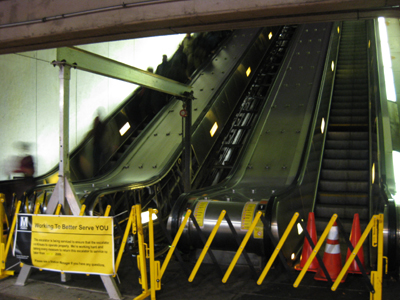 So, the escalators on the Metro are so often out of service, we just had to know WMATA's explanation. They gave us one.
So, the escalators on the Metro are so often out of service, we just had to know WMATA's explanation. They gave us one.Here's Metro's unedited explanation of the escalator issue. We added some information in brackets.
The Washington Metropolitan Area Transit Authority is one of the largest single owners of vertical transportation in the country. We have 588 Escalators (including the largest single span units in the northern hemisphere at our Wheaton station on the Red Line) and 244 Elevators. These are maintained by 192 employees with a budget of $29.5 million (FY09). If you were to stack all of our elevators and escalators, it would reach from the top of Mt. McKinley, the highest point in North America to 2400 feet below sea level.
Some of our escalators are between 20 and 30 years old and take a far greater pounding than the ones in office buildings or local shopping malls.
WMATA’s elevators and escalators are overseen by five Jurisdictional Authorities:
· Department of Consumer Regulatory Affairs in the District
· Department of Labor Licensing Regulations in Maryland
· Office of Building Code Services in Fairfax County
· Department of Community Planning Housing and Development in Arlington County
· Office of Building and Fire Code Administration in the city of Alexandria
There are sixteen critical safety functions constantly monitored on escalators this includes every critical moving part all the way down to how fast the hand rail is moving in relationship to the steps.
The number of switches and sensors varies depending on length, type and location of each individual escalator. For example, there are safety sensors the entire length of an escalator to monitor if a foot gets between the step and the side wall, which is why you see brushes along the sides of the escalators, to keep your feet away from danger. (And you thought these were there to shine your shoes.)
There are safety sensors connected to the comb plates at the top and bottom of every unit. These are very sensitive sensors and will shut an escalator off with the slightest pressure, which you would be thankful for if you got your foot stuck in one.
Roughly 66% of escalator shut downs are caused by safety switch activations [by riders]. Every time an escalator shuts down because of one of these sensors, we need to dispatch a technician to trouble shoot the problem and re-set the unit. [The time for this to occur, Metro says, varies.]
Metro is also in the fourth year of a six-year program to rehabilitate 206 escalators system wide at a cost of $50 million. Typically, it takes two to three months to modernize each unit. Modernization of escalator units has improved service reliability over the last several years.
Although the mantra seems to be stand to the right and walk to the left, people really shouldn’t walk on moving escalators. Simply put, escalator steps were not intended for walking. They are much larger than regular steps. Walking increases the risk of tripping, falling and being injured or hurting someone else.
[Walking up or down an escalator is not only potentially dangerous, as Metro says, but it causes more wear and tear, according to "Mathematics and Physics for Programmers." (A true must read!)
"Subway operators often complain about the additional wear and tear on the machinery due to people walking up the stairs. If people choose to walk up the escalator, then the escalator has to exert the force necessary to propel them faster. This means it needs greater power. On the other hand, increasing the velocity decreases the time during which they are on the escalator, which decreases the total mass being lifted."Furthermore, standing on the right causes additional mechanical wear and tear.]
Many customers don’t realize how dangerous escalators are. The many recent incidents across the country involving soft soled shoes (such as flip-flops and Crocs) and escalators should remind everyone that escalators are large, dangerous machines. Even with all the safety switches they should be treated with respect.
Additional reading:
Crocs sued for escalator accident
10,000 escalator accidents per year
Other news:
Blue/Yellow problems to persist through week (WTOP)
Purple Line moves forward (Biz Journal)
Photo: Thomas Wilburn





















 Oct. 11, 2012
Oct. 11, 2012 February 21, 2012
February 21, 2012 March 4, 2010
March 4, 2010





5 comments:
I wasn't aware of the extensive installations of sensors along the sides and teeth. It truly makes me wonder why on Earth they have not installed more generalized motion senors at each end to detect when no riders are on the escalators. They have these in much of modern Europe, and it seems to be a sensible way to reduce the huge and needless amount of wear on the escalators, not to mention the egregious amount of electricity that is wasted by empty escalators running all night on weekends at, e.g., Federal Triangle...
Every one of those stairbots should be ripped out and replaced with a flight of good old concrete stairs, plus handrails. The elevators would remain to serve the halt and the lame, and the money wasted on the stairbots could be spent on railcars and track maintenance.
Fewer fat people would just be icing on the cake.
Credit for the image would have been appreciated, guys.
all escalators out of service at Bethesda for the evening rush hour on Jan 27, 2010. Elevators were dreadfully slow.
Of course, no announcement from Metro while on the (packed) trains due to Friendship Hts cluster fail.
Huntington recently completed its part of the system-wide escalator overhauls. And tonight, the escalators are not working. Neither are the ones at Foggy Bottom, BTW.
The whole issue with Metro seems to be: It was not designed to be a major, heavy-duty, commuter rail system. Not the trains, not the tracks, not the stations nor the facilities. So we're just wearing it out through overuse. What the answer to that problem?
Post a Comment